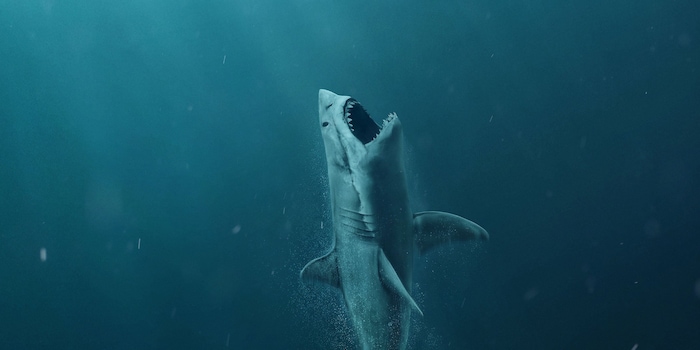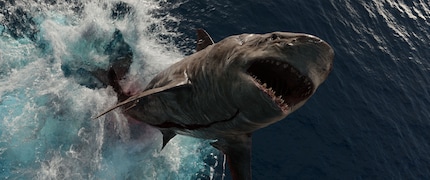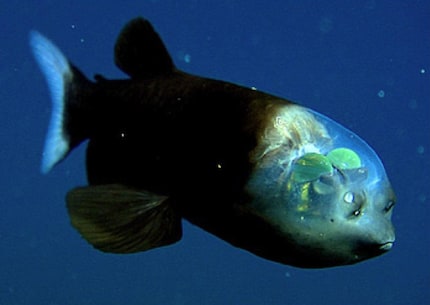
The Meg versus logic and evolution theory
This action film promises the best of Jason Statham and prehistoric sharks. The film itself is entertaining but it falls flat when you pit it against science. What’s more exciting is the megalodon sharks in the film. Because let’s face it, in evolutionary terms The Meg makes no sense.
The film cuts to a little girl looking out of the window of the Chinese underwater base. She’s met with the cold eyes of a huge grey shark on the other side of the glass. It’s the megalodon, the biggest shark there ever was but it died out two million years ago. Now the monster is back and devouring everything in its wake: from beach bathers to submarine crews. But it has to come up against action hero Jason Statham.
On paper, the film looks like a recipe for success. Just the idea of Jason Statham drop-kicking a shark is reason enough to buy cinema tickets. And a beer and popcorn to round off a perfect evening.
The problem is that in the actual film Jason Statham doesn’t end up drop-kicking any sharks. And there are loads of people in the film who aren’t Jason Statham and who babble on about some other stuff instead of drop-kicking something or someone. And then there’s the aggressive Chinese self-promotion in Hollywood films.
But what’s even worse is the interpretation of the screenwriters, Dean Georgaris, Jon Hoeber and Erich Hoeber. Why are there three screenwriters when the film is based on one book? Incidentally, the book excels where the film disappoints. That’s because Georgaris and the Hoebers know nothing about nature, evolution and reality. The author Steve Alten, on the other hand, gave thought to time and evolution.
A glimpse into the depths of the ocean
The plot of «The Meg» goes something like this: within the Mariana trench, which was thought to be the lowest point on Earth, there’s an even deeper section that is concealed by an impenetrable hydrogen sulfide cloud. As a result, this section has developed its own ecosystem over the course of millions of years. The creatures that live down there aren’t interested in hydrogen sulfide so they stay in complete darkness. That’s until the oceanographers from the Chinese underwater station come and penetrate the cloud.
They shine a light around the deep section of the trench and in doing so put a spotlight on everything that hadn’t seen the light of day for millions of years. Including the megalodon shark.

White and glowing
Sharks in the seas we know haven’t evolved any further for millions of years. But evolution wasn’t put on pause, because no living thing can fight the process of evolution. Over the course of generations, organisms adapt to their environment. For instance, Nepalese have lungs that cope better with thin air in the mountains.
Slow-worms stopped using their legs as they didn’t have much use for them any more. As you can see, evolution doesn’t just add features to an organism, it also takes them away if the need disappears.

That’s what the megalodon in «The Meg» hasn’t come across. Essentially, the Meg looks like a big shark. Wrong. In the book, the Meg is snowy white and glowing. That’s down to evolution. Sharks are grey on their backs and white on their stomachs because they rarely swim with their bellies facing upwards. And pigmentation is nothing other than internal sun protection.
That’s also why pale people burn faster than those with darker skins. In the same vein, grey sharks use their pigmented skin to protect themselves from the sun. And deep sea fish such as barreleye fish that live 400 to 2,500 metres beneath the surface are partly or even completely transparent.
So it stands to reason that Steve Alten’s Meg is white. And the beast developed bioluminescence that let it light up in the dark. Natural light diffuses a great deal in deep sea. It helps to attract prey and enable communication between animals.
Interestingly, the process is dominated by two materials: luciferin, a light-producing substance and the enzyme luciferase. These materials are activated by the animal either on purpose or subconsciously and that’s why it lights up.
Animating an entire white shark and making it light up in the dark was too complex according to trivia on the film database IMDB. That’s why the megalodon ended up being grey. But that’s not what visual effects supervisor Adrian de Wet says in the special effects magazine VFXvoice:
The creature is described in the books as looking like a huge albino great white. However, that was really not what the director Jon Turteltaub wanted at all. He wanted something that looked prehistoric. And while it makes evolutionary sense for it to have ended up albino and blind after countless millennia in the total darkness of 10 km deep, Jon felt that that didn’t work for his vision. Instead he wanted it to look gnarled, textured, aggressive, moody, and dark – most definitely not a great white.
Can we have a bit of evolution now?
Even though the animators disregarded evolution for the most part, they did consider the fact that the Meg had to survive down there somehow. At the bottom of the ocean the water has less oxygen. In keeping with that, the film features the bothersome hydrogen sulfide clouds.
The director Jon Turteltaub was quoted in the film magazine Cinema Review as saying the production team were careful not to just make a big white shark even bigger. «We gave our Meg more gills than a shark would have because we conjectured that in the oxygen-poor environment at the bottom of the ocean, it might have evolved extra gills.»
But then the film goes against evolution again. In Steve Alten’s book the Meg only hunts at night because the old megalodon sharks lived and hunted in the darkest depths of the sea. This meant their eyes were accustomed to the pitch-black and were extremely sensitive to light.
But when you watch the film, you’ll see the megalodon munching through a beach on a bright sunny day.
The shark would explode anyway
These stories are all well and good but the Meg would burst like a balloon. Or at least, that’s what one theory claims. Their reasoning is that deep sea fish struggle to come up to the surface. While there are certain types of deep sea fish that can survive and are even healthy in shallow water, marine biologists had difficulty believing this was the case for the likes of the Meg. Swim bladders burst, cells destabilise and what looks like a lovely red sea cucumber under the water quickly turns into a red soup on the surface.
The creatures that would struggle the most are fish with a swim bladder or air bladder. In reality, this only refers to bony fish. Because if they didn’t have a swim bladder, they’d just sink. This organ fills with air and gives them stability in the water, including a stable diving depth.
When the fish breathes out, the swim bladder adapts, pushes out air or takes it in. All of that takes time. This means if the fish comes to the surface or dives too quickly, the air bladder expands uncontrollably with oxygen. This pushes the organs to the side, meaning the heart stops beating and the fish dies.
But sharks aren’t part of the bony fish family. They’re fish that have a skeleton made of cartilage rather than bone (cartilaginous fish). Sharks have to keep moving so as not to sink. They don’t even have any moving gills, just gill slits. These are used for taking in oxygen from the water but the liquid itself isn’t absorbed. The slits filter it out. But as soon as a shark stops moving, it starts to suffocate.
Just because sharks and megalodon don’t have swim bladders, this doesn’t mean they would get over a quick trip to the surface for a snack at the beach. Even a megalodon and other types of deep sea fish have oxygen in their blood. In other words, there’s a chance the megalodon would explode as it rose to the surface.
At the end of the day, the difference this would make to the film is minor: Jason Statham still wouldn’t have drop-kicked a shark and other people would still have talked nonsense and not kicked any sharks either.
On a personal note
I don’t do this often but the ocean and waters are important to me. Sharks are some of the creatures that get an awful reputation despite the fact they’re endangered. That’s why I like to support a charity called Shark Trust. The organisation uses education, research, campaigning, policies and direct action in an attempt to create a healthy and balanced marine ecosystem so sharks and other sea creatures can continue to live.
Journalist. Author. Hacker. A storyteller searching for boundaries, secrets and taboos – putting the world to paper. Not because I can but because I can’t not.
Interesting facts about products, behind-the-scenes looks at manufacturers and deep-dives on interesting people.
Show all